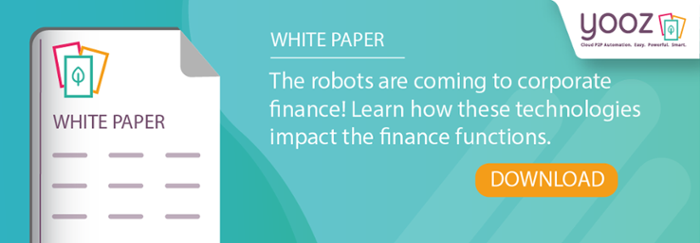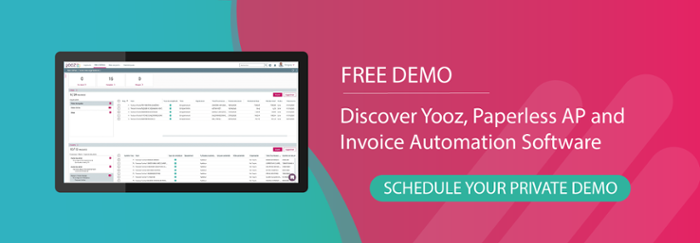Try answering the following question: How much time do Accounts Payable (AP) staff typically spend on answering vendor inquiries related to invoices? The answer may be surprising to many. The fact is that AP staff spend almost a quarter of their time on inquiries. That's a significant amount of work spent answering phone calls and emails, hunting down papers, pulling folders, checking payment status, and other similar time-consuming tasks.
In terms of efficiency, this is not time well-spent. It’s also a costly distraction from the truly productive work needed to get invoices processed and paid on time. There is, however, a solution to get rid of the delays and errors associated with handling paper and sticking to manual processes. It’s called technology, or more specifically, digital transformation.
Why Companies Are Investing in Intelligent Finance Automation
The idea of digital transformation in finance isn’t something new. However, if there was a single event that truly drove home the point to embark on intelligent automation in finance, it was the massive disruption caused by the global pandemic. Survey after survey has documented how COVID-19 has exacerbated the problems caused by manual processing. There’s a silver lining, though, as it has begun to reshape the finance function as we know it.
When Yooz polled more than 1,000 finance leaders in the US and seven other countries earlier this year, 70% of US businesses told us that the pandemic was a wake-up call. It has pushed them to accelerate their digital transformation plans and helped prioritized investments in the cloud and in software-as-a service. The key driver? The pain they experienced during lockdowns and work-from-home mandates.
Staff was cut, dispersed all over the place, and often unable to get access to important financial documents and productivity tools. As a result, work piled up, bills went unprocessed and unpaid, and relationships with suppliers suffered. Not to mention the serious financial (cash-flow) problems some businesses had to deal with as payment cycles kept getting longer and longer. It was quite the unhappy learning experience and, if left static, these issues would delay the recovery for many companies.
Little wonder that organizations took the learning experience and told us that circumstances helped them to realize the urgency to do more than just go digital. They were able to identify a need to fully automate their finance processes from purchase to payment (P2P). This type of investment into digital transformation and into financial process automation, in particular, is the one key takeaway from our report “The State of Automation in Finance”.
Intelligent Automation Makes it All Easy
Intelligent P2P automation of financial processes combines Robotic Process Automation (RPA) and Machine Learning Algorithms (MLA) to handle purchase orders, invoices, and payments not just faster, but also makes each finance transaction safer and cheaper. Don't misunderstand, intelligent automation isn't a replacement for humans. What an automated system does is take over the labor-intensive, rules-based, and repetitive back-office tasks such as extracting data or moving files based on specified parameters. This in turn frees up employee time from repetitive tasks and inspires them to create new business value.
Instead of overseeing every little detail humans only have to step in when they can really make a difference. For example, reviewing an item that has been flagged for erroneous, incomplete, or suspicious details or to engage with a vendor to build a better relationship. Checking in when things are running smoothly and discussing more favorable terms is definitely a better use of time than the old game of phone tag and chasing paper. It certainly makes for a much more interesting workday.
Indeed, with an intelligent, cloud-based automation platform, you never have to worry about approval backlogs, missing records or paying late. Easily scalable, it automates the entire workflow for businesses of any size and delivers the same quality experience. Team members enjoy one single interface in their browser or on their mobile device to review, approve, and initiate payments at any time and from any place.
Of course, words are backed by numbers. All these intelligent automation benefits add up to 80% savings per invoice processed and cycle times that are measure in days or hours instead of weeks and months.
The Five Steps of Intelligent Automation in Finance
Intelligent financial process automation in finance can be broken down into five steps that are familiar to any organization. Let's take a closer look.
First, incoming documents are instantly captured regardless of their format, from paper invoices that needs to be scanned and email attachments all the way to an electronic submission. Companies that already embrace this kind of digital transformation can get started in under an hour. Without prior configuration, they can still see accuracy rates of 80% or more (clearly faster than any manual process).
Artificial intelligence correctly extracts all the relevant information from an invoice. In the case of Yooz, not only does the company have decades of experience but the platform has already read and indexed more than 100 million documents from more than one million different vendors. The software is easily able to automatically GL-code amounts, match an invoice to a PO, and verify details such as supplier address, bank, or tax information.
Next up in is a streamlined review process. Invoices are routed to the right people in the right order to be signed off according to smart workflows easily set up and customized by each individual organization. Straight-through processing means as little human intervention as possible, lowering the risk of costly errors and mistakes. What’s more, automation creates a detailed audit trail that lets staff immediately pull up invoices with a simple keyword search.
Why Payments Are a Key Part of Invoice Automation
Fourth in line is automating the payment process. Intelligent finance automation is a complete end-to-end process and with options such as the YoozPay module, an organization can set up ultrafast and efficient payments. Vendors are onboarded using a single email address and one-click selection of a preferred payment method. Not only does using an electronic check or virtual credit card mean instant payment and additional protection against fraud. It also unlocks cash-back as a new, recurring revenue stream that can add thousands of dollars to the bottom line even for a small to midsize business. The accounts payable department just became a profit center and the CFO just became even happier.
Fifth and finally, the last step is also intelligently automated. All relevant information is instantly exported to more than 250 financial software and ERP packages, reconciling payment status with purchase orders.
Unfortunately, truth be told, even despite the pandemic and resulting wake-up call, not all businesses are there yet. According to our survey, 20% of companies are still using Excel spreadsheets and manual processes for their accounts payable function, and just 18% have adopted full automation in their finance processes.
The Pitfalls of a Piecemeal Approach
While we've been discussing the benefits of full financial process automation for many companies, digital transformation is still a piecemeal approach. While a fraction of businesses are using data verification tools such as Optical Character Recognition (OCR) or Electronic Document Management Solutions (EDMS) - and this does help - these do not provide the cost, time and productivity benefits of a fully automated tool.
Hesitating to embrace end-to-end automation means leaving money on the table now, and risks losing out to the competition down the road. Organizations are often held back by false fears. Many believe the process of switching to financial process automation is complex (23%), time-consuming (22%) and expensive (18%). While this many have been true in the past, it is no longer the case. In fact, far from it.
Streamlining AP workflows now can cut the processing time from weeks to days and drastically slash administrative costs. Case in point is the time companies spend on handling vendor invoices in a month. For the average US company, that task consumes 32 hours a month.
Live Dashboards Show the Value
Even more important are the benefits of increased visibility for all parties involved. Picture a live dashboard that shows key metrics in real-time. Even better, the value of this financial intelligence keeps getting better with every bit of data that comes in.
When core finance processes are automated, your finance team can start exploring more sophisticated activities, such as investigating and reducing fraud risk, undertaking detailed cost modeling, and supporting the strategic direction of the entire organization. It’s safe to say that the rise of intelligent automation in finance will change the way organizations operate forever.
And that one-quarter of accounts payable staff time spent on vendor inquiries? Thanks to finance automation, it's no longer a concern.







